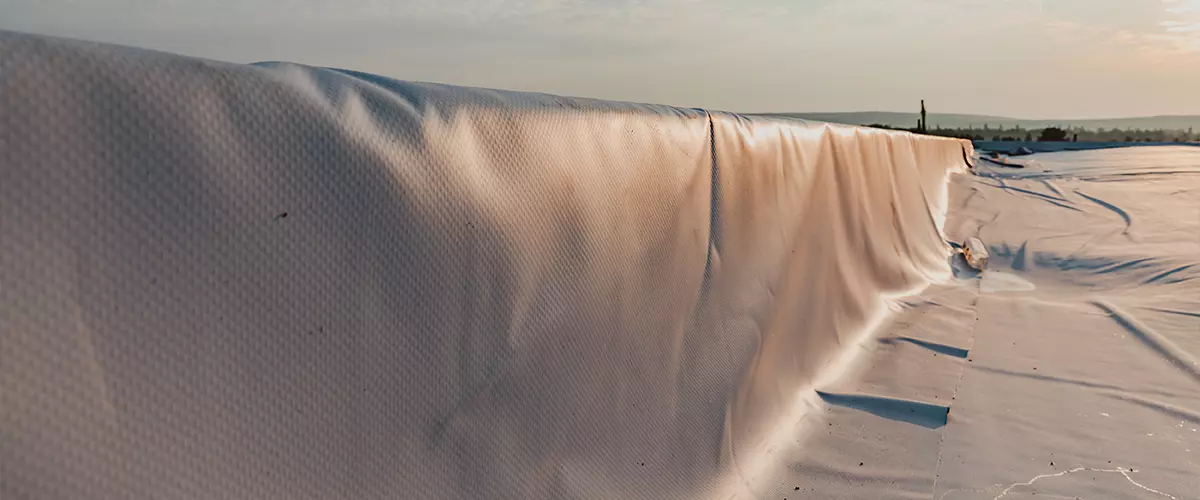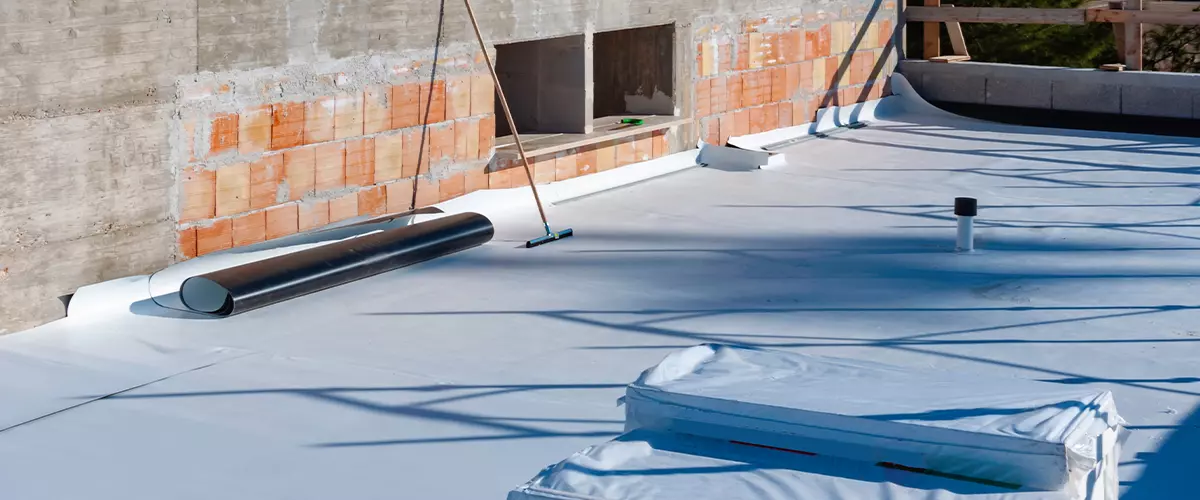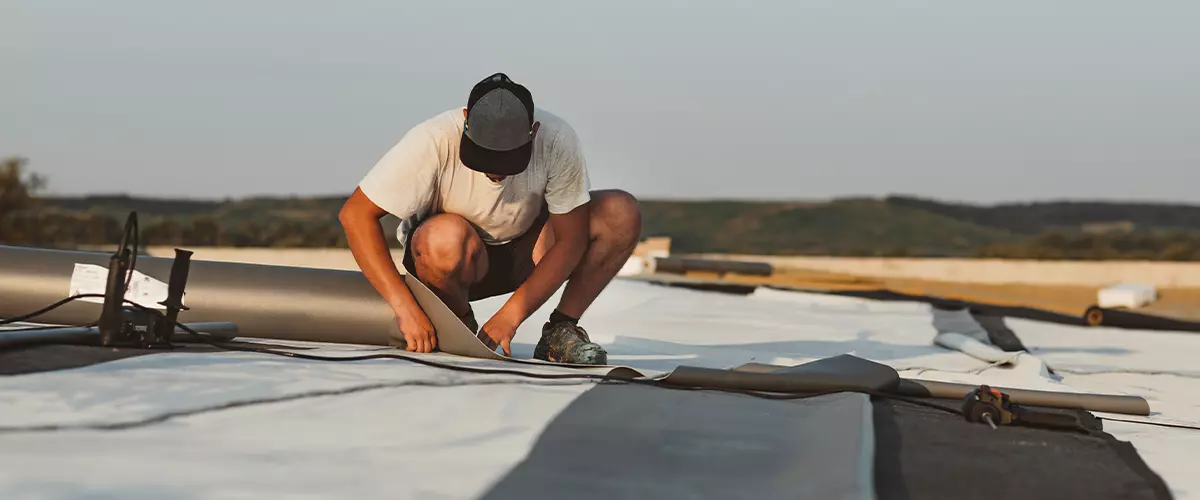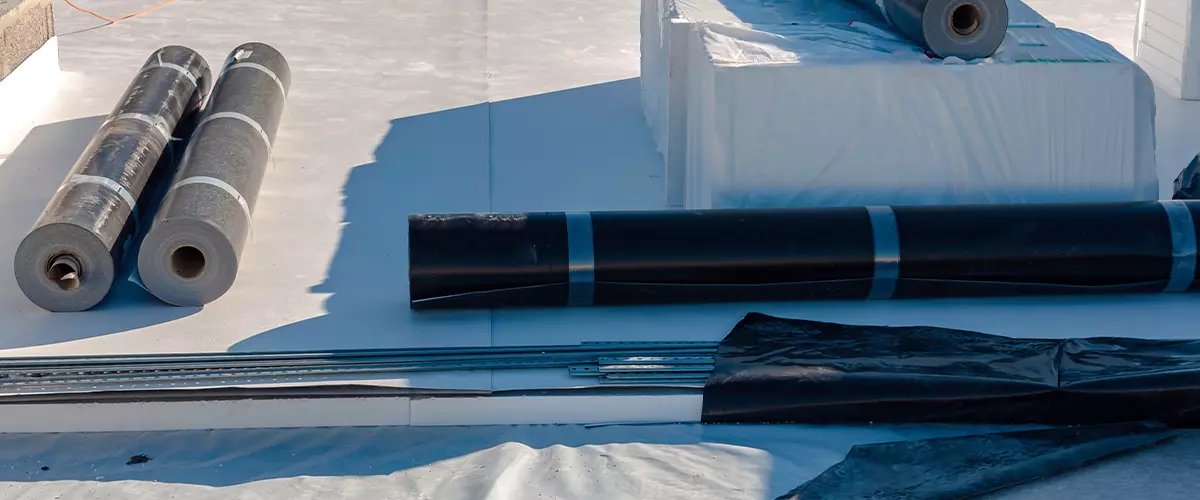TPO (Thermoplastic Olefin) roofing is a single-ply roofing membrane that has taken the commercial roofing industry by storm. It’s a blend of polypropylene and ethylene-propylene rubber, offering a high degree of durability and resistance to UV rays and heat.
The prime advantage of TPO roofing is its energy efficiency. The reflective surface of a TPO roof deflects sunlight, reducing interior cooling costs during hot months, a feature that translates to considerable savings over time.
In terms of cost, installing a TPO roofing system typically ranges between $5 and $6 per square foot, though prices can vary based on factors such as location, roof complexity, and labor rates.
Welcome to our comprehensive 2023 guide to TPO roofing, where we teach you everything you need to know about one of the most popular roofing choices of the year!

What Is TPO Roofing?
Installation Brief
TPO roofing installation involves the placement of large, flat sheets of TPO membrane onto the roof, which are then heat-welded at the seams to form a continuous, waterproof covering. This method not only ensures efficient installation but also minimizes potential points of leakage, enhancing the overall lifespan and reliability of your roof.
Material Composition
Is It Good?

Pros and Cons of TPO Roofing
Like any roofing material, TPO has its strengths and weaknesses. It’s essential to consider these pros and cons before deciding on TPO roofing for your commercial building.
Pros
- Energy Efficiency: TPO roofing, with its highly reflective surface, contributes to significant energy savings by deflecting sunlight and reducing cooling costs.
- Durability: TPO is resistant to UV rays, heat, and most forms of environmental damage, ensuring a long lifespan for your roof.
- Eco-friendly: TPO is recyclable, making it an excellent choice for businesses looking to reduce their environmental impact.
Cons
- Inconsistent Quality: Given the relative newness of TPO roofing, the quality can vary significantly between manufacturers.
- Shorter Lifespan: While TPO roofing is durable, its lifespan is shorter compared to some other roofing materials, such as EPDM or metal roofing.
- Installation Complexity: TPO roofing requires specialized installation, which can lead to higher labor costs.
Costs of TPO Roofing
When considering TPO roofing for your building, it’s essential to factor in the full range of costs, not just the upfront expenses. The cost of a TPO roofing system varies based on several factors, including the complexity of the roof, geographic location, and labor rates.
On average, the installation of a TPO roof can range from $5 to $6 per square foot. However, these costs can escalate for complex roof designs or in regions where labor rates are high. Keep in mind that while the initial investment might seem high, the energy savings TPO provides can offset these costs over time.
Besides installation, there are also ongoing costs to consider. These include routine maintenance and repair costs. Regular maintenance of a TPO roof is generally minimal and includes cleaning and periodic inspections to identify any necessary repairs early on. Repair costs, on the other hand, can vary widely depending on the nature of the damage.
Remember that while TPO roofing might have a shorter lifespan compared to materials like metal or EPDM, its affordability, combined with its energy efficiency, makes it a cost-effective choice for many commercial buildings.

TPO vs. Other Roofing Materials
TPO vs. EPDM
TPO vs. Metal Roofing
TPO vs. PVC
Eco-Friendliness and Recyclability of TPO Roofing
In the era of sustainability and environmental responsibility, the eco-friendly attributes of TPO roofing are particularly appealing. TPO roofing materials are environmentally friendly in two primary ways.
Environmentally Friendly Production Process
100% Recyclable
Reflective Surface and Heat Mitigation
In addition to these eco-friendly features, the highly reflective surface of TPO roofs helps to mitigate the urban heat island effect by reflecting solar heat rather than absorbing it. This quality not only reduces cooling costs but also decreases the energy consumption and carbon emissions associated with air conditioning.
All these attributes make TPO roofing a smart choice for businesses aiming to enhance their sustainability and reduce their environmental impact.
Top TPO Roofing Brands
- GAF: Known for its technological innovation and commitment to quality, GAF is one of the leading TPO roofing manufacturers. Their EverGuard® TPO line is especially popular due to its superior durability and energy efficiency.
- Firestone Building Products: Firestone’s UltraPly™ TPO roofing system offers excellent performance and sustainability. It’s a reliable choice for both new construction and re-roofing applications.
- Carlisle SynTec Systems: Carlisle’s Sure-Weld® TPO is well-regarded for its durability and strength. It features the industry’s first and only OctaGuard XT™ Weathering Package for unbeatable weathering protection.
- Holcim Elevate: Holcim Elevate offers a variety of TPO roofing solutions that are sustainable, energy-efficient, and durable. Their TPO roofs are made to withstand extreme weather conditions, providing long-lasting coverage.
- Mule-Hide Products: Mule-Hide’s TPO roofing systems combine flexibility, reflectivity, and excellent weathering characteristics. They offer several systems, each designed to meet specific building requirements, making them a versatile choice for commercial roofing.
- GenFlex: GenFlex is widely recognized for its high-quality and easy-to-install TPO roofing systems. They provide a balance of excellent performance, cost-effectiveness, and environmental sustainability.

Durability & Warranty Offered by Manufacturers
When it comes to roofing, durability is a paramount consideration. TPO roofing systems are known for their robust physical properties, including resistance to UV radiation, punctures, and tears. These characteristics contribute to their long lifespan, typically around 15-20 years.
The durability of your TPO roof can extend significantly with proper installation and maintenance, leading to a lifespan of up to 30 years in some cases.
When considering warranty, manufacturers of TPO roofing offer a variety of warranty options, which can range from 10 to 30 years, depending on the specific product and installation method. It’s important to understand the parameters of these warranties, what they cover, and their terms and conditions.
For instance, many warranties cover material defects, but fewer offer coverage for system warranties that include both materials and labor.
Here’s a glimpse into what some top-notch brands offer:
- GAF’s EverGuard® TPO has a limited warranty for up to 20 years, and they also offer the option for extended warranty coverage.
- Firestone Building Products provides a standard limited warranty for their UltraPly™ TPO roofing system and offers upgrades to premium warranties.
- Carlisle SynTec Systems offers various warranty options for their Sure-Weld® TPO, including warranties for hail damage and accidental puncture.
- Holcim Elevate provides a standard limited warranty for their TPO roofing solutions, with premium warranty options available.
- Mule-Hide Products offers a limited warranty on their TPO roofing systems and also provides the option of an extended Maintenance Agreement Guarantee for select roofing systems.
- GenFlex’s warranty options include limited warranties that cover material defects, workmanship, and system warranties.
Warranties play a vital role in providing peace of mind and ensuring that your investment in a TPO roof is well-protected. When selecting a TPO roofing product, make sure to discuss warranty options with your chosen manufacturer or roofing professional to understand the level of protection offered. Remember, a strong warranty from a reputable manufacturer is a testament to the quality of their TPO roofing products.
Preparing for TPO Roof Installation: Insulation and Ventilation
When preparing for the installation of a TPO roof, it’s crucial to consider two key factors: insulation and ventilation. Proper insulation is essential to maintain indoor temperature and reduce energy costs. TPO roofs often come with an insulating layer, but depending on the local climate and building code requirements, additional insulation may be needed.
Ventilation, on the other hand, is vital to prevent moisture accumulation, which can cause mold growth and structural damage. A well-ventilated roof also helps to prolong the lifespan of the TPO roofing system.
Maintenance and Repairs of TPO Roofing
Like any other roof, TPO roofing requires regular maintenance to ensure its longevity. Maintenance practices generally include routine inspections, especially after extreme weather events, regular cleaning to prevent debris buildup, and prompt repairs when needed.
While TPO roofs are known for their durability, they can develop issues such as punctures, mildew growth, or seam gaps over time. Timely detection and repair of these issues can prevent more significant, costly damage in the future.
Remember that while TPO roofing is a durable and cost-effective solution, its performance largely depends on proper installation, regular maintenance, and prompt repair when necessary.

TPO Roofing FAQs
TPO roofing, which stands for Thermoplastic Olefin, is a type of roofing material that’s made from a single layer of synthetics and reinforcing scrim.
TPO roofing has become a favorite in the industry due to its energy efficiency. It’s exceptional at reflecting UV rays, which helps keep buildings cooler and reduces the need for air conditioning. Besides, its white surface doesn’t absorb heat like darker roofing materials.
TPO is also known for being more affordable than many other roofing options. Plus, it’s durable and resistant to mold, dirt, tears, and punctures. And if you’re a fan of eco-friendly solutions, you’ll be happy to know that TPO is 100% recyclable.
But like anything else, it’s not perfect. Installation of TPO roofing can be complex, and it must be done properly to ensure all the benefits. There’s also the issue of the seams – if they’re not correctly heat-welded, leaks can occur.
TPO roofing is indeed a good choice for many buildings. It’s not only cost-effective but also highly durable and eco-friendly. The white surface reflects sunlight, keeping buildings cooler and reducing energy costs.
Plus, it’s resistant to many common roofing issues, making it a low-maintenance option. However, it’s crucial to work with a professional for installation to ensure the best results. With proper installation and maintenance, a TPO roof can be a great long-term investment for your property.
Choosing between EPDM and TPO often comes down to your specific needs and budget. If cost is a major factor, EPDM might be a better choice as it’s typically less expensive. But if energy efficiency is your priority, TPO’s reflective properties might tip the scales in its favor.
Both are durable, with TPO being more resistant to punctures and tears. Remember, the right choice for you is the one that best suits your unique needs. Always consult with a professional roofer to make the best-informed decision.
TPO roofing is remarkably robust, designed to withstand various weather conditions. Thanks to its flexibility, it resists cracks and tears even in extreme temperatures. Plus, its strong seams are heat-welded, making them more resistant than those of other roofing types.
However, remember that the longevity and strength of your TPO roof largely depend on professional installation and regular maintenance.
Team Up With Omaha's Top Home Builder
Don’t let indecisiveness delay your roofing project. We know the choices can be overwhelming, but rest assured, our team is here to guide you through every step. From TPO roofing and beyond, our expertise in home building services ensures a seamless installation process tailored to your preference.
Dreams of a new, resilient roof are just a call away. Reach us at (402) 804-9321 or send us a message if you live in Omaha, NE, or surrounding areas, and let’s begin the journey of transforming your home.
